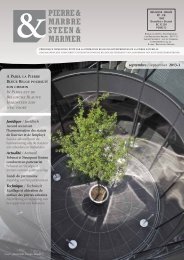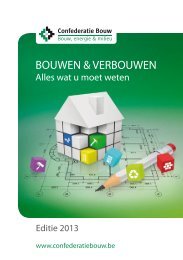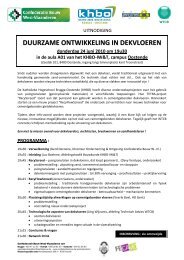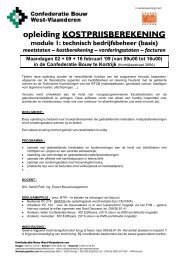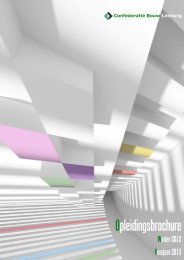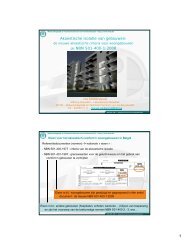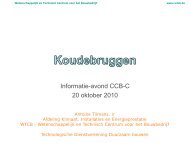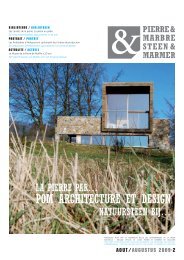Venez à Mons, la pierre bleue Vous y accueillera KoM naar bergen ...
Venez à Mons, la pierre bleue Vous y accueillera KoM naar bergen ...
Venez à Mons, la pierre bleue Vous y accueillera KoM naar bergen ...
Create successful ePaper yourself
Turn your PDF publications into a flip-book with our unique Google optimized e-Paper software.
- Réhabilitation dans un bac.<br />
Dans ce cas, le matériau est p<strong>la</strong>cé dans un bac, ce<strong>la</strong> permet de contrôler<br />
<strong>la</strong> croissance et de limiter le développement des racines. La même<br />
chose pourrait être envisagée <strong>à</strong> Angkor Vat, ou les panneaux de grès<br />
sont manquants. La végétation peut combler <strong>la</strong> <strong>la</strong>cune tout en restant<br />
réversible et en limitant les infiltrations d’eau. P<strong>la</strong>cée dans un bac, les<br />
racines et les interactions avec <strong>la</strong> structure sont limitées.<br />
Fig.1 : L’arbre mature maintient les <strong>pierre</strong>s entre elles. Temple du Ta Som.<br />
Fig.1 : De rijpe boom houdt de stenen bij elkaar<br />
Fig.2 : Bas-relief situé sous forêt naturellement érodé en surface. Cliché T. Diwo.<br />
Fig.2 : Bas-reliëf onder de bomen vooraan op natuurlijke wijze aangetast. . Cliché T. Diwo.<br />
Fig.3 : Bas-relief exposé aux intempéries, <strong>la</strong> détérioration est sévère. Cliché GACP<br />
Fig.3 : Bas-reliëf blootgesteld aan weer en wind, de beschadiging is ernstig. Cliché GACP.<br />
Fig.4 : Relief couvert de lichen est entier.<br />
Fig.4 : Het reliëf bedekt met korstmos is nog geheel<br />
Fig.5 : Relief non colonisé très endommagé par des fendillements et éc<strong>la</strong>tements.<br />
Fig.5 : Onbedekt reliëf erg beschadigd door scheuren en barsten.<br />
Clichés M-F. André.<br />
Fig.6 : Fromager du temple du Ta Prohm.<br />
Fig.6 : Kapokboom van de tempel van Ta Prohm.<br />
Fig.7 : Simu<strong>la</strong>tion d’un mur perdu par Marino L., Gaudio R, De Caria T.<br />
Fig.7 : Simu<strong>la</strong>tie van een verloren muur door Marino L., Gaudio R, De Caria T.<br />
Fig.8 : Volume perdu pouvant être signalé par des végétaux. Temple de Banteay Kdei.<br />
Fig.8 : Verloren ruimte die zou kunnen beveiligd worden door p<strong>la</strong>ntenbegroeiing. Tempel van Banteay Kdei.<br />
Fig.9 : Réhabilitation p<strong>la</strong>cée dans un bac par Marino L., Gaudio R, De Caria T.<br />
Fig.9 : Renovatie in een bak door Marino L.,Gaudio R., De Caria T.<br />
Fig.10 : Perte des panneaux de grès, temple d’Angkor Vat.<br />
Fig.10 : Verlies van de leisteenp<strong>la</strong>ten, Angor Wat tempel<br />
20 <strong>pierre</strong> & marbre - steen & marmer - 2011 / 3<br />
- Renovatie in een bak<br />
In dit geval wordt het materiaal in een bak gep<strong>la</strong>atst. Zo kan de groei<br />
en ontwikkeling van de wortels in bedwang worden gehouden. Dat<br />
is ook mogelijk in Angkor Wat, waar er zandpanelen ontbreken. De<br />
vegetatie kan de leemte opvullen hoewel ze nog omkeerbaar blijft en<br />
waterinsijjpeling kan beperken.<br />
Références : / Referentiewerken<br />
ANDRÉ M-F, « L’arbre et le lichen <strong>à</strong> Angkor : destructeurs ou protecteurs de <strong>la</strong> <strong>pierre</strong> ? », dans Le végétal et l’architecture : confrontation et valorisation,<br />
séminaire de l’Institut National du Patrimoine (Villeneuve-lès-Avignon, 18-20 novembre 2008), Paris : Institut National du Patrimoine, 2008.<br />
ANDRÉ M-F., La <strong>pierre</strong> monumentale face aux agressions atmosphériques, cours Centre de Formation aux Métiers du Patrimoine, communication<br />
orale, Siem Reap-Angkor, 10-11 juin 2010.<br />
ARIÑO N, ORTEGA-CALVO J.J., GOMEZ-BOLEA A., et al, « Lichen colonization of the Roman pavement at Baelo C<strong>la</strong>udia (Cadiz, Spain) : biodeterioration<br />
vs. bioprotection », dans The Science of the Total Environment, Amsterdam : Elsevier, 167, 1995, p.353-363.<br />
DEL MONTE M., SABBIONI C., ZAPPIA G., « The origin of calcium oxa<strong>la</strong>tes on historical buildings, monuments and natural outcrops », The Science of<br />
the Total Environment, Amsterdam : Elsevier Science Publishers B.V., 67, 1987, p.17-39.<br />
FUSEY P., Altérations biologiques des grès cambodgiens et recherche de moyens de protection, Essai de synthèse, Paris : EFEO, 1991.<br />
HONEYBORNE D., « Weathering and decay of masonry » dans Conservation of building and decorative stone, (éd.) J. Ashurst et F.G. Dimes, Oxford :<br />
Butterworth-Heinmann, vol.1, 1998, p.153-184.<br />
MARINO L., GAUDIO R. et DE CARIA T., « La conservation par le végétal. Fiabilité didactique et réversibilité », dans Vestiges archéologiques en milieu<br />
extrême, Paris : Monum, 2003, p.192-207.<br />
MORGANTI G., Verde e ruine. Origini e applicazioni dell’uso di elementi vegetali nel restauro di antichita’ come caso di integrazione delle <strong>la</strong>cune,<br />
Bisconti G. et Druissi G. (éd), Lacune in Architettura, Aspetti Teorici ed Operativi, Actes du Congrès (Bressanone, 1-4 juillet 1997), Venise : Arcadia<br />
Ricerche, 13, 1997, p.141-153.<br />
WENDLER E. ET PRASARTSET C., « Lichen growth on old Khmer-style sandstone monuments in Thaï<strong>la</strong>nd : Damage or shelter ? », ICOM CC, Londres :<br />
James and James, 1999, vol.2, p.750-754.<br />
FUSEY P., Altérations biologiques des grès cambodgiens et recherche de moyens de protection, 1991, p.24.<br />
HONEYBORNE D., « Weathering and decay of masonry » dans Conservation of building and decorative stone, p.167.<br />
MARINO L., GAUDIO R. et DE CARIA T., « La conservation par le végétal. Fiabilité didactique et réversibilité », dans Vestiges archéologiques en milieu<br />
extrême, 2003, p.194.<br />
ANDRÉ M-F., La <strong>pierre</strong> monumentale face aux agressions atmosphériques, cours CFMP, communication orale, 2010.<br />
ANDRÉ M-F, « L’arbre et le lichen <strong>à</strong> Angkor : destructeurs ou protecteurs de <strong>la</strong> <strong>pierre</strong> ? », dans Le végétal et l’architecture : confrontation et<br />
valorisation, 2008, p.3.<br />
WENDLER E. et PRASARTSET C., « Lichen growth on old Khmer-style sandstone monuments in Thaï<strong>la</strong>nd : Damage or shelter ? », 1999, p.753.<br />
ARIÑO N, ORTEGA-CALVO J.J., GOMEZ-BOLEA A., et al, « Lichen colonization of the Roman pavement at Baelo C<strong>la</strong>udia (Cadiz, Spain) : biodeterioration<br />
vs. bioprotection », dans The Science of the Total Environment, 167, 1995, p.357.<br />
WENDLER E. ET PRASARTSET C., op. cit, p.752.<br />
WENDLER E. ET PRASARTSET C, op. cit, 1999.<br />
DEL MONTE M., SABBIONI C., ZAPPIA G., « The origin of calcium oxa<strong>la</strong>tes on historical buildings, monuments and natural outcrops », The Science<br />
of the Total Environment, 67, 1987, p.17.<br />
Morganti G., « Verde e ruine. Origini e applicazioni dell’uso di elementi vegetali nel restauro di antichita’ come caso di integrazione delle <strong>la</strong>cune »,<br />
Architettura, Aspetti Teorici ed Operativi, Actes du Congrès (Bressanone, 1-4 juillet 1997), 13, 1997, p.143.<br />
MARINO L., GAUDIO R. et DE CARIA T., « La conservation par le végétal. Fiabilité didactique et réversibilité », dans Vestiges archéologiques en milieu<br />
extrême, 2003.



